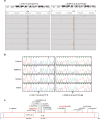Identification of variants in pleiotropic genes causing "isolated" premature ovarian insufficiency: implications for medical practice
- PMID: 29706645
- PMCID: PMC6117257
- DOI: 10.1038/s41431-018-0140-4
Identification of variants in pleiotropic genes causing "isolated" premature ovarian insufficiency: implications for medical practice
Abstract
Next-generation sequencing (NGS) is increasingly being used in a clinical setting for the molecular diagnosis of patients with heterogeneous disorders, such as premature ovarian insufficiency (POI). We performed NGS of ~1000 candidate genes in four unrelated patients with POI. We discovered the genetic cause of "isolated" POI in two cases, both of which had causative variants in surprising genes. In the first case, a homozygous nonsense variant in NBN was causative. Recessive function-altering NBN variants typically cause Nijmegen breakage syndrome characterized by microcephaly, cancer predisposition, and immunodeficiency, none of which are evident in the patient. At a cellular level, we found evidence of chromosomal instability. In the second case, compound heterozygous variants in EIF2B2 were causative. Recessive EIF2B2 function-altering variants usually cause leukoencephalopathy with episodic decline. Subsequent MRI revealed subclinical neurological abnormalities. These cases demonstrate that variants in NBN and EIF2B2, which usually cause severe syndromes, can cause apparently isolated POI, and that (1) NGS can precede clinical diagnosis and guide patient management, (2) NGS can redefine the phenotypic spectrum of syndromes, and (3) NGS may make unanticipated diagnoses that must be sensitively communicated to patients. Although there is rigorous debate about the handling of secondary/incidental findings using NGS, there is little discussion of the management of causative pleiotropic gene variants that have broader implications than that for which genetic studies were sought.
Conflict of interest statement
The authors declare that they have no conflict of interest.
Figures



References
Publication types
MeSH terms
Substances
LinkOut - more resources
Full Text Sources
Other Literature Sources
Medical
Research Materials
Miscellaneous

